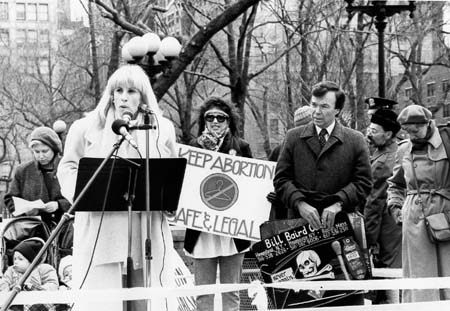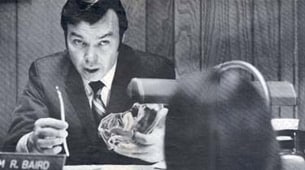by Alexis Greene
Over the years, Bill Baird, the reproductive rights activist, has been threatened, arrested and jailed.
He’s been called a seducer, a self-promoter and a menace to society.
He also once provoked a significant Supreme Court decision – Baird v. Eisenstadt – which in 1972 ruled that birth control information and devices could be distributed to unmarried women upon request.
In short, the 76-year-old Baird has had a colorful and significant career, but one that apparently has been ignored or forgotten since Roe v. Wade entered the pro-choice vocabulary in 1973.
At the University of Massachusetts, Amherst, a group of historians and theater folk recently sought to redress what they perceived as history’s dismissive treatment of Baird.
Spurred by Dr. Joyce Berkman, a professor of history and long-time friend of the activist, a team of undergraduate and graduate students researched and wrote a documentary play called A Menace to Society, which received a public staged readings on December 12 and 13, 2008.
How do you translate activism to the stage?
The playwright Emily Mann is known for creating what she calls “Theatre of Testimony.” In Execution of Justice – Mann’s 1983 play about the murders of San Francisco Mayor George Moscone and City Supervisor Harvey Milk – Mann delved into trial transcripts, and interviewed men and women involved directly and indirectly with the events. Using people’s actual words, she forged a drama that asks audiences to confront homophobia.
The dramatist and actor Anna Deavere Smith used a similar approach to build her performance pieces Fires in the Mirror: Crown Heights, Brooklyn and Other Identities and Twilight: Los Angeles, 1992. In Smith’s case, however, she not only interviewed people, she embodied them and their words — and their political perspectives – through her performance.
Moisés Kaufman, the playwright and director who conceived The Three Trials of Oscar Wilde and The Laramie Project, about the murder of gay university student Matthew Shepard, also relied on primary sources and, for Laramie, first-person accounts.
The activism of these plays is two-fold. It exists in each author’s determination to put certain political issues front and center. And it exists in the action, characters and language each playwright presents.
To bring Bill Baird’s story to the stage, the production’s dramaturg, Emily Denison, and nine researchers plunged into archives, searching for legal briefs, newspaper articles and personal accounts. In her program notes, Denison recalls visiting Baird’s home in Massachusetts and being “astounded by the hundreds of boxes, drawers and shelves filled with documents” about him and the cause he championed.
Denison funneled the research to the script’s writers, Madeline ffitch and Jeannie Hoag, both graduate students in creative writing, both in their late 20s. Madeline ffitch, who runs an experimental theater company in Northampton called The Missoula Oblongata, had collaborated on plays but never on a documentary. Jeannie Hoag had never written a play at all.

The two writers were undaunted by their relative inexperience, or by the piles of material that they needed to cull and shape.
“I gave myself the freedom to read through everything,” says ffitch, who described the process during a recent telephone conversation. “It helps your imagination. I just read a lot, and the theatrical parts of the research came through clearly: first-person accounts of illegal abortions, Baird speaking at Boston University in 1967, when he was arrested for giving birth control foam to a woman in the crowd.”
Indeed, one of the script’s most forceful moments occurs when Baird describes the event that raised his consciousness about the urgency of legalizing birth control and abortion:
“…in 1963, I was at Harlem Hospital. I heard a woman screaming—the kind of screaming that if you heard it you knew someone was in great pain. I raced out into the corridor…and I saw this young mother. I found out later she was 29 years of age, the mother of eight….She staggered down the hallway and she had a piece of coat hanger sticking out of her uterus…she was covered in blood.”
As to the form of their play, ffitch and Hoag found models in Moisés Kaufman’s documentary dramas. Says Hoag, “The Three Trials and Laramie jump around in time, and they combine dialogue from different times and characters to create conversations.”
In A Menace to Society, the writers blend past and present, and interweave dialogue from disparate sources, relying frequently on evocative personal accounts to give immediacy to the story.
“I felt that this play would be a workman like piece, in the sense that we were not trying to do anything experimental theatrically,” says ffitch. “The method is transparent. The theater of it is not overstated or flashy. It relies on piecing together a lot of research material.”
As with Laramie, in which eight actors played more than 60 roles, the Menace ensemble of 10 performers took numerous parts.
Looking back on the process, Menace’s director, Shawn LaCount, described it as “a difficult project.”
“There are a lot of decisions to make when you’re doing documentary theater,” says LaCount. “How educational should it be? How dramatic? How accurate? We all struggled in a positive way with those questions.”
At the core of their wrestling was the question of how to present the character of Baird, who, by his own account, had drawn fire from notable feminists such as Betty Friedan and Gloria Steinem, from Robin Morgan, and from Alan Guttmacher, president of the Planned Parenthood Federation of America in the late 1960s and early 1970s—among many others. Baird’s family—his first wife and four children—turned against him politically and religiously (Baird recently remarried).
“We had a meeting with him early in the process,” LaCount recalls, “and I expressed concern that, when you do a ‘biopic,’ it’s difficult not to offend. Frankly, I think the script was kind to him.”
LaCount would have liked to see Menace focus more on Baird’s personal story, in the manner of the film MILK about Harvey Milk. “I’m much more interested in the man—someone who’s ready to risk years of his own life and almost sacrifice his family—to a cause. The fact (is) that the man is fighting cancer at the moment.”
Hoag alludes to “some hesitation about how much we should be looking at his personality, because he was involved with the project.”
But ffitch has no regrets about their approach. “I think that Bill Baird as a person comes across,” she says. “But I wanted to put Bill’s life in the context of the groundswell for choice.”
Finally, perhaps, the necessary ingredient in any attempt to bring activism to the stage is the revolutionary ardor of the creators. Talk with Emily Mann, Anna Deavere Smith or Moisés Kaufman, and you will find human beings dedicated to civil rights, adamantly against violence and hate crimes, however objective they believe they need to be on the page.
Both of the Menace writers indicate that their consciousness was raised about the risk to Roe v. Wade in the current political climate. “It made me a lot more aware, and a little anxious about the state of things,” says Hoag.
“I observed how language changes over the years,” says Madeline ffitch. “Women of my mother’s generation spoke about abortion in a more frank way than we do now. The pro-choice side is letting the anti-choice side set the tone, the vocabulary. The anti-choice side has hyped the vocabulary, and I think the pro-choice side should be more unapologetic in the way it talks about abortion.”
Both writers indicate that they are committed to the causes to which Bill Baird devoted his life. Still, by anyone’s count, Baird is still the angriest person in the room.
“Time is not on our side,” Baird says toward the end of A Menace to Society. “Unless we become more aggressive, you will witness the death of this abortion law in a couple of years.”
“Social reformers get weary and frightened. But a voice within me keeps reminding me to think of that woman with a coat hanger.”
Alexis Greene is a New York-based author, editor and theater critic who writes about the performing arts and about women. Her book The Story of 42nd Street, written with Mary C. Henderson, was released in fall 2008 by Watson-Guptill/Random House, and her book Front Lines: Political Plays By American Women, edited with Shirley Lauro, will be published in spring 2009 by The New Press.

